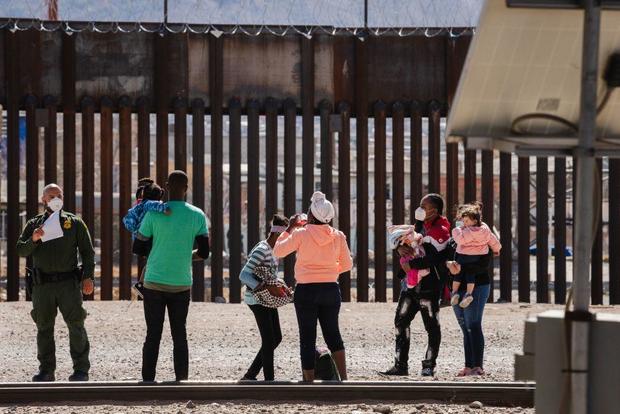Washington — During his second week in office, President Biden gave officials nine months to issue regulations that could make it easier for migrants fleeing gang or domestic violence to secure asylum, a policy that would signal a clear repudiation of Trump administration attempts to close off the U.S. asylum system.
But two years later, amid record arrivals along the U.S.-Mexico border, the Biden administration has yet to issue the rules that could expand asylum eligibility. Instead, the administration finds itself expanding a Trump-era border policy that blocks certain migrants from requesting asylum and proposing limits on asylum eligibility.
Since Mr. Biden commissioned the asylum eligibility rules in a February 2021 executive order, there have been disagreements within his administration over how generous the regulations should be, three people with direct knowledge of the debates told CBS News, requesting anonymity to describe internal deliberations.
Some top administration officials have voiced concern about issuing rules that could make additional migrants eligible for asylum and make it more difficult to deport them while the administration is focused on reducing unlawful border crossings, the sources said.
Despite Mr. Biden instructing his administration to issue them before November 2021, it’s unclear when the regulations might be published by the Departments of Justice and Homeland Security, which oversee the judges and officers who decide whether migrants should be granted asylum or deported.
In a statement to CBS News, Department of Homeland Security spokesperson Angelo Fernández Hernández said officials were still working towards publishing the regulations, but did not describe the reasons for the delay nor provide a publication time frame.
“This rulemaking is a critical part of the Administration’s efforts to rebuild and improve the U.S. asylum system and refugee resettlement program, and the Administration is committed to issuing it,” Fernández Hernández said. “Since President Biden issued Executive Order 14010 directing the development of the rule, Departments and agencies have been diligently and extensively collaborating on this joint rulemaking process. We look forward to publication of a proposed rule once it has been finalized.”
JUSTIN HAMEL/AFP via Getty Images
An administration official said the rules are designed to create uniform asylum eligibility standards and ensure “fairness and efficiency, not making it any easier or harder to get asylum.” But advocates for asylum-seekers said the regulations could help certain migrants, including women fleeing gender-based violence, to win asylum amid decades of inconsistent court decisions on these cases.
The delay in issuing the regulations illustrates a broader tension in the administration between Mr. Biden’s lofty campaign promises to dismantle his predecessor’s hardline asylum policies and the political and operational implications of an unprecedented migration crisis along the southern border.
In fact, as part of a border strategy unveiled earlier this month that pairs increased enforcement measures to deter illegal crossings with expanded opportunities for certain migrants to enter the U.S. legally, the Biden administration said it would propose a regulation that would restrict — not expand — asylum eligibility.
As described by DHS, migrants would be subject to “a rebuttable presumption of asylum ineligibility” if they enter the U.S. illegally after failing to to seek refuge in other countries en route to the U.S. The proposal has elicited blistering backlash from advocates and some Democratic lawmakers, who have noted the restriction would resemble a Trump administration rule known as the “transit ban” that was struck down in federal court.
The Biden administration has rejected the comparisons, saying its asylum restriction will contain humanitarian exemptions. It has also noted that it is extending legal migration opportunities to migrants with U.S.-based sponsors and vulnerable asylum-seekers who request to enter the U.S. via a mobile app.
Still, critics of the proposed asylum restriction say it would abandon Mr. Biden’s vow to fully restore U.S. laws that give migrants on U.S. soil the right to request asylum, which is available to those fleeing persecution based on their race, religion, nationality, membership in a particular social group or political opinion.
“The transit ban is wholly inconsistent with a legal and humane asylum system, which the president promised when he took office,” said Lee Gelernt, the lead immigration attorney at the American Civil Liberties Union. “We have heard nothing that legally distinguishes the Biden transit ban from the Trump ban, and would therefore immediately sue if the administration goes through with its plans.”
Mr. Biden’s revamped border strategy also includes an expansion of the Title 42 border expulsion policy, which cites public health concerns to block migrants from seeking asylum. The Biden administration has said the border restriction first implemented by the Trump administration can no longer be justified on public health grounds, but the Supreme Court in late December allowed border officials to continue enforcing it at the request of Republican-led states.
Cecilia Muñoz, who served as President Barack Obama’s top immigration adviser, said the Biden administration is operating under the constraints of an overwhelmed system that Congress has failed to reform. Some of Mr. Biden’s ambitious immigration promises during the campaign, she said, were made in response to demands from progressive advocates.
“This particular promise related to the asylum process was always going to be hard to keep,” said Muñoz, who helped oversee Mr. Biden’s transition team. “The ‘rock and a hard place’ that the administration have to manage here is the rock of unrealistic expectations on the left and the desire to politicize and bash everything they do on the right.”
JIM WATSON/AFP via Getty Images
The Biden administration’s shifting approach on asylum policy is part of a long-standing debate over who should qualify for safe harbor in the U.S. The debate has intensified in recent years as record numbers of migrants have arrived along the southern border, overwhelming an understaffed and under-resourced system.
In fiscal years 2021 and 2022, U.S. border officials stopped migrants 4 million times, federal statistics show. While about half of these migrants were quickly expelled from the U.S. under Title 42, the other half were allowed to request asylum. The record border arrivals have further strained the U.S. immigration court system, where fewer than 700 judges are overseeing over 2 million unresolved cases.
The Trump administration — which argued the asylum system is abused by migrants fleeing economic misfortune, not persecution — issued several policies to restrict asylum and expedite the deportation of migrants. Through legal opinions, it generally barred asylum claims based on domestic or gang violence.
During the 2020 campaign, Mr. Biden vowed to restore U.S. asylum laws, denouncing Trump administration policies as draconian. In one of the presidential debates, he derided Mr. Trump for being “the first president in the history of the United States” who declared that “anybody seeking asylum has to do it in another country.”
In his February 2021 executive order, Mr. Biden instructed officials to conduct a “comprehensive examination” within 180 days to “evaluate whether the United States provides protection for those fleeing domestic or gang violence in a manner consistent with international standards.” The president also gave officials 270 days to propose regulations to define the “particular social group” asylum category.
In June 2021, the Justice Department revoked the legal opinions that had disqualified migrants fleeing domestic or gang violence from asylum, and said those cases would be governed by the rules Mr. Biden ordered to define “particular social group.”
As the most ambiguous asylum category, “particular social group” has been at the center of debate for decades, with courts issuing competing opinions over who exactly can claim asylum on that ground. Women fleeing female genital cutting, domestic abuse or other gender-based violence, migrants escaping gang persecution and LGBTQ individuals have sought asylum through that category, with varying degrees of success.
The George W. Bush and Obama administrations sought to define “particular social group” through regulations, but they were never finalized. Because of different court decisions, migrants seeking asylum on that ground currently must prove that the group is formed by people who share a common “immutable” characteristic, is “socially distinct” within a society and has “sufficient particularity” that defines it.
Advocates for asylum-seekers have said the current legal threshold is nearly impossible to satisfy. The current U.S. standards also differ from a more expansive definition of a particular social group by the United Nations.
Blaine Bookey, legal director at the Center for Gender and Refugee Studies, a group that serves women seeking asylum, called the internal opposition within the Biden administration to issuing the particular social group regulations “unprincipled,” saying that denied asylum-seekers could face danger after being deported.
Bookey also rejected the argument that the rules could fuel more migration, arguing the regulations would help the government make asylum processing more efficient and expeditious, as adjudicators would have uniform guidelines to decide claims.
“It is a fallacy to think that asylum-seekers living in rural Guatemala who are fleeing for their lives are going to be looking and thinking about complex U.S. legal standards, and whether they can meet them in order to determine whether they should escape to save their life or not,” Bookey said.
Andrew Selee, president of the Migration Policy Institute, a nonpartisan think tank, said Mr. Biden’s decision to toughen migration enforcement stemmed from a desire to mitigate the political backlash over the record border arrivals. It was also a recognition, Selee said, that the U.S. does not have the resources and personnel to quickly process the asylum claims of all the migrants arriving along the southern border.
“I think they were driven by an honorable idealism, and at some point, the realities and the difficulties of balancing equities at the border has caught up,” Selee said. “It is a question about how you balance access to legal pathways, protection and enforcement.”


